Cannabis edible
| Part of a series on |
| Cannabis |
|---|
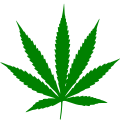 |
|
Chemistry |
|
Economics |
|
Regional
|
|
A cannabis edible, also known as a cannabis-infused food or simply an edible, is a food product that contains cannabinoids, especially tetrahydrocannabinol (THC).[1] Although edible may refer to either a food or a drink, a cannabis-infused drink may be referred to specifically as a liquid edible or drinkable.
Most edibles contain a significant amount of THC, which can induce a wide range of effects, including relaxation, euphoria, increased appetite, fatigue, and anxiety.[2] THC-dominant edibles are consumed for recreational and medical purposes.[3] Some edibles contain a negligible amount of THC and are instead dominant in other cannabinoids, most commonly cannabidiol (CBD).[4] These edibles are primarily used for medical purposes only.[4]
Foods and beverages made from non-psychoactive cannabis products are known as hemp foods.[5]
History
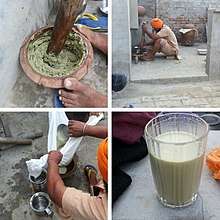
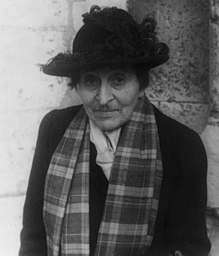
The first known cannabis-infused food was in India, where people have prepared food and drink with bhang for millennia, for both spiritual and medicinal purposes.[6] The oil-solubility of cannabis extracts was also known to ancient Indians, with Sanskrit recipes requiring cannabis to be sautéed in ghee before mixing it with other ingredients.[7]:7[8]
Modern interest in cannabis-infused food is credited to the publication of The Alice B. Toklas Cookbook. Toklas included a recipe for "haschich fudge", which was contributed by artist and friend Brion Gysin when the book was published in 1954. Although it was omitted from the first American editions, Toklas' name and her "brownies" became synonymous with cannabis in the growing 1960s counterculture.[9]
In some U.S. states that have legalized cannabis, edibles have experienced a dramatic rise in sales.[10] However, there is growing concern about the danger edibles pose to children and inexperienced cannabis consumers, who may easily consume too much at once, possibly not even realizing the food has been infused.[11][12]
Chemistry and pharmacology
Because cannabis does not naturally include THC, but rather its precursor THCA, cannabis must be decarboxylated in order to convert THCA into THC. THCA degrades into THC, which then degrades into cannabinol, while being stored; THCA is rapidly, but not completely, decarboxylated when heated.[13]
Comparing effects of eating cannabis products and smoking them is difficult because there are large margins of error due to variability in how different people smoke, with the number, duration, and spacing of puffs, the hold time and the volume of the person's lungs all affecting the dosing. With regard to eating, different vehicles in which cannabinoids are dissolved for oral intake affect the availability of the cannabinoids, and different people metabolize differently.[14] Generally, however, because oral doses are processed by the digestive system and the liver before entering the bloodstream, cannabinoids that are ingested are absorbed more slowly and have delayed and lower peak concentrations, and are cleared more slowly, compared to inhaling them in the aerosol that is formed when cannabis is burnt.[14] Oral administration generally leads to two peaks of concentration, due to enterohepatic circulation.[14]
Consuming THC through ingestion results in absorption through the liver and, through metabolic processes, the conversion of a significant proportion of it into 11-hydroxy-THC.[14]
Types
Baked good
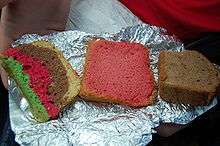
A cannabis-infused baked good is a common type of cannabis edible. Popular varieties include hash cookies, pot brownies, and space cakes.
One is not usually able to distinguish between regular baked goods and those containing cannabinoids before consumption, but they tend to have a slightly green tinge and they often emit a faint cannabis smell. A mild grassy or cannabis flavor might be detectable if sufficient quantities are used. Many resources for recipes, preparation, and dosage are available online, though they vary greatly in effectiveness and quality.[7]:7
Drink
A cannabis-infused drink, also known as a liquid edible or drinkable, is a drink that has been infused with cannabinoids.
Traditional cannabis-infused drinks include the Indian drinks lassi and thandai when prepared with bhang. Cannabis tea is a mildly psychoactive herbal tea but is psychoactively weak due to the lack of fat and alcohol in the drink.
In U.S. states that have legalized cannabis for recreational use, drinks were about 4% of the cannabis market in 2014 but had fallen to around 1.5% of the market in 2016.[15][16]
Capsule
A capsule containing THC or CBD that are not sold as regulated pharmaceuticals are also considered edibles and provide the same effect as food and drink.[17]
Ingredients
Tincture

Cannabis tincture is an alcoholic extract of cannabis. Because cannabis resins are soluble in alcohol, an effective way of adding them into dishes is through cooking brandy or rum infused with cannabinoids. Generally, stems and leaves of the marijuana plant are used due to their lower THC content when smoked. When infused in high-proof grain-based alcohol, such as Everclear, it becomes what is commonly known as green dragon. Creme de Gras (a play on the English "grass", as creme de gras translates literally as "cream of fat") is a flavored liqueur made from cannabis.[7]:31 It can be added to coffee and other beverages.
Oil
Cannabis oil is a product based in a cooking oil that has been infused with cannabinoids by mixing cannabis with the heated oil. Cannabis cooking oils are available to medical cannabis patients in a variety of blends for various cooking applications.[18]
Butter
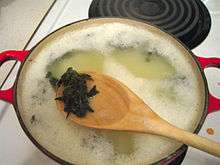
Cannabis-infused butter, or cannabutter, is a cannabis-infused ingredient used in many cannabis edibles.[19] Heating the raw cannabis in melted butter allows the cannabinoids to be extracted by the fat. A more complicated process is using a double-boiler, or slow cooker, cheesecloth or tea strainer and funnel.[20]
See also
References
- ↑ "Drug Alert: Marijuana Edibles". JustThinkTwice.gov. Retrieved October 20, 2017.
- ↑ "What are marijuana effects?". DrugAbuse.gov. Retrieved October 20, 2017.
- ↑ Crombie, Noelle. "Oregon's recreational marijuana market expands to edibles and extracts starting Thursday". OregonLive.com. Retrieved October 20, 2017.
- 1 2 Terps, Tyler. "10 Little-Known Uses for CBD Oil". HighTimes.com. Retrieved October 20, 2017.
- ↑ Pierre Bouloc (16 September 2013). Hemp: Industrial Production and Uses. CABI. pp. 229–. ISBN 978-1-84593-793-5.
- ↑ Staelens, Stefanie. "The Bhang Lassi Is How Hindus Drink Themselves High for Shiva". Vice.com. Retrieved August 10, 2017.
- 1 2 3 Gottlieb, Adam (1993). Cooking with Cannabis: The Most Effective Methods of Preparing Food and Drink with Marijuana, Hashish, and Hash Oil. Ronin Publishing. ISBN 0-914171-55-0.
- ↑ Drake, Bill (2002). The Marijuana Food Handbook. Ronin Publishing. p. 18. ISBN 0-914171-99-2.
- ↑ Eplatt, Layla (April 20, 2015). "Go Ask Alice: The History of Toklas' Legendary Hashish Fudge". Scientific America. Retrieved 22 September 2016.
- ↑ Lacsamana, Pauline. "Edible Marijuana Sales Continue to Rise, With Gummies and Mints Topping Sales". TheDailyMeal.com. Retrieved August 10, 2017.
- ↑ "The rise of legal weed in America". TheWeek.com. Retrieved August 10, 2017.
- ↑ "Edible marijuana: What we need to know". TheConversation.com. Retrieved October 20, 2017.
- ↑ Kerstin Iffland; Michael Carus; Franjo Grotenhermen (2016), Decarboxylation of Tetrahydrocannabinolic acid (THCA) to active THC (PDF), European Industrial Hemp Association
- 1 2 3 4 Huestis, MA (2005). "Pharmacokinetics and metabolism of the plant cannabinoids, delta9-tetrahydrocannabinol, cannabidiol and cannabinol". Handbook of experimental pharmacology (168): 657–90. doi:10.1007/3-540-26573-2_23. PMID 16596792.
- ↑ Borchardt, Debra (June 29, 2016). "Marijuana Drinks Not Causing a Buzz". Forbes.
- ↑ News, A. B. C. (2011-01-29). "Company Introduces Marijuana Soda". ABC News. Retrieved 2017-07-28.
- ↑ "The Best Types of Edibles". High Times. 2018-06-03. Retrieved 2018-06-18.
- ↑ "Cooking With Cannabis | New Haven Independent". New Haven Independent. 2017-07-25. Retrieved 2017-07-28.
- ↑ "Foodie Gossip: Cooking with Cannabis: Medical Edibles Go Mainstream". Foodiegossip.blogspot.com. 2010-12-10. Retrieved 2011-01-25.
- ↑ Pilcher, Tim. The Cannabis Cookbook. Running Press. ISBN 978-0-7624-3090-1.
External links
| Wikibooks Cookbook has a recipe/module on |
- The Straight Dope column on Alice B. Toklas brownies (includes original text of recipe)